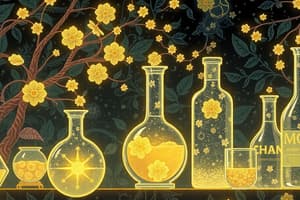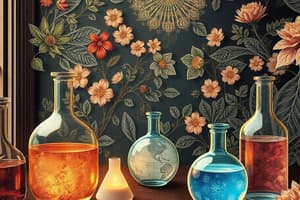Podcast
Questions and Answers
What is the primary focus of organic chemistry?
What is the primary focus of organic chemistry?
- The study of chemical reactions in living organisms
- The study of properties of matter
- The study of carbon-containing compounds (correct)
- The study of inorganic substances
Which of the following describes a chemical property of a substance?
Which of the following describes a chemical property of a substance?
- Melting point of the substance
- Color of the substance
- Reactivity with acids (correct)
- Density of the substance
Which state of matter has a definite shape and volume?
Which state of matter has a definite shape and volume?
- Plasma
- Liquid
- Gas
- Solid (correct)
What is the definition of a compound?
What is the definition of a compound?
In which type of mixture are the components not uniformly distributed?
In which type of mixture are the components not uniformly distributed?
Which of the following is an example of a physical property?
Which of the following is an example of a physical property?
What distinguishes extensive properties from intensive properties?
What distinguishes extensive properties from intensive properties?
Which branch of chemistry is concerned with the physical principles governing chemical processes?
Which branch of chemistry is concerned with the physical principles governing chemical processes?
What is the first step in the scientific method?
What is the first step in the scientific method?
What do significant figures in a measurement represent?
What do significant figures in a measurement represent?
Which particles are found in the nucleus of an atom?
Which particles are found in the nucleus of an atom?
What does the atomic number of an atom represent?
What does the atomic number of an atom represent?
How are periods organized in the periodic table?
How are periods organized in the periodic table?
What is a reactant in a chemical reaction?
What is a reactant in a chemical reaction?
What is the purpose of balancing chemical equations?
What is the purpose of balancing chemical equations?
Which of the following is NOT a subatomic particle?
Which of the following is NOT a subatomic particle?
Flashcards
Chemistry Definition
Chemistry Definition
The study of matter, its properties and changes; fundamental to understanding the world around us
Matter
Matter
Anything that takes up space and has mass
Organic Chemistry
Organic Chemistry
Study of carbon-containing compounds
Physical Properties
Physical Properties
Signup and view all the flashcards
Chemical Properties
Chemical Properties
Signup and view all the flashcards
Element
Element
Signup and view all the flashcards
Compound
Compound
Signup and view all the flashcards
Homogeneous Mixture
Homogeneous Mixture
Signup and view all the flashcards
Scientific Method
Scientific Method
Signup and view all the flashcards
Measurement
Measurement
Signup and view all the flashcards
SI Units
SI Units
Signup and view all the flashcards
Atomic Structure
Atomic Structure
Signup and view all the flashcards
Periodic Table
Periodic Table
Signup and view all the flashcards
Chemical Reaction
Chemical Reaction
Signup and view all the flashcards
Reactants
Reactants
Signup and view all the flashcards
Chemical Equation
Chemical Equation
Signup and view all the flashcards
Study Notes
Introduction to Chemistry
- Chemistry is the study of matter, its properties, composition, and the changes it undergoes.
- Matter is anything that occupies space and has mass.
- Chemistry is fundamental to understanding the world around us, from the smallest atoms to the largest stars.
- Chemistry is closely related to other sciences, such as physics, biology, and geology.
Branches of Chemistry
- Organic chemistry: the study of carbon-containing compounds.
- Inorganic chemistry: the study of all substances except organic compounds.
- Physical chemistry: the study of the physical principles governing chemical processes.
- Analytical chemistry: the study of the composition of matter.
- Biochemistry: the study of the chemistry of living organisms.
Properties of Matter
- Physical properties: properties that can be observed or measured without changing the substance's composition. Examples include color, odor, melting point, boiling point, density, and solubility.
- Chemical properties: properties that describe how a substance reacts with other substances to form new substances. Examples include flammability, reactivity with acids, and oxidation.
- Intensive properties: properties that do not depend on the amount of matter present. Examples include density, temperature, and color.
- Extensive properties: properties that depend on the amount of matter present. Examples include mass, volume, and length.
States of Matter
- Solid: has a definite shape and volume. Particles vibrate in fixed positions.
- Liquid: has a definite volume but takes the shape of its container. Particles are close together but can move past each other.
- Gas: has neither a definite shape nor a definite volume. Particles are far apart and move randomly.
Elements and Compounds
- Element: a substance that cannot be broken down into simpler substances by chemical means. Examples include hydrogen (H), oxygen (O), carbon (C), and iron (Fe).
- Compound: a substance composed of two or more elements chemically combined in a fixed ratio. Examples include water (H₂O), carbon dioxide (CO₂), and sodium chloride (NaCl).
Mixtures
- Mixture: a combination of two or more substances that are not chemically bonded. Mixtures can be separated by physical means.
- Homogeneous mixture: a mixture in which the components are uniformly distributed throughout the mixture. Example: saltwater solution.
- Heterogeneous mixture: a mixture in which the components are not uniformly distributed throughout the mixture. Example: a sand and water mixture.
The Scientific Method
- Observation: noticing and describing a phenomenon.
- Question: asking a question about the observed phenomenon.
- Hypothesis: proposing a possible explanation for the phenomenon.
- Experiment: designing and conducting an experiment to test the hypothesis.
- Analysis: interpreting the results of the experiment.
- Conclusion: drawing a conclusion about whether the hypothesis is supported or rejected.
Measurements and Units
- Measurement: a quantitative description of a property; includes both a number and a unit.
- SI units: the International System of Units. A standardized system for measurement, essential for scientific communication.
- Significant figures: the number of digits in a measurement that are known with certainty plus one uncertain digit. Accuracy and precision are key concepts related to the reliability of measurement.
Atomic Structure
- Atom: the fundamental building block of matter.
- Subatomic particles: protons, neutrons, and electrons.
- Nucleus: contains protons and neutrons.
- Electron cloud: region surrounding the nucleus where electrons are located.
- Atomic number: number of protons in an atom.
- Atomic mass: sum of protons and neutrons in an atom.
Periodic Table
- Periodic table: a table that organizes elements by their properties.
- Periods: horizontal rows in the periodic table.
- Groups: vertical columns in the periodic table.
- Trends: periodic trends in atomic size, ionization energy, electronegativity, and metallic character.
Chemical Reactions
- Chemical reaction: a process that results in the transformation of one or more substances into one or more new substances.
- Reactants: the substances that undergo changes in a chemical reaction.
- Products: the new substances formed in a chemical reaction.
- Chemical equations: symbolic representations of chemical reactions, showing the reactants and products involved.
- Balancing chemical equations: ensuring that the number of atoms of each element is the same on both sides of the equation.
Studying That Suits You
Use AI to generate personalized quizzes and flashcards to suit your learning preferences.




